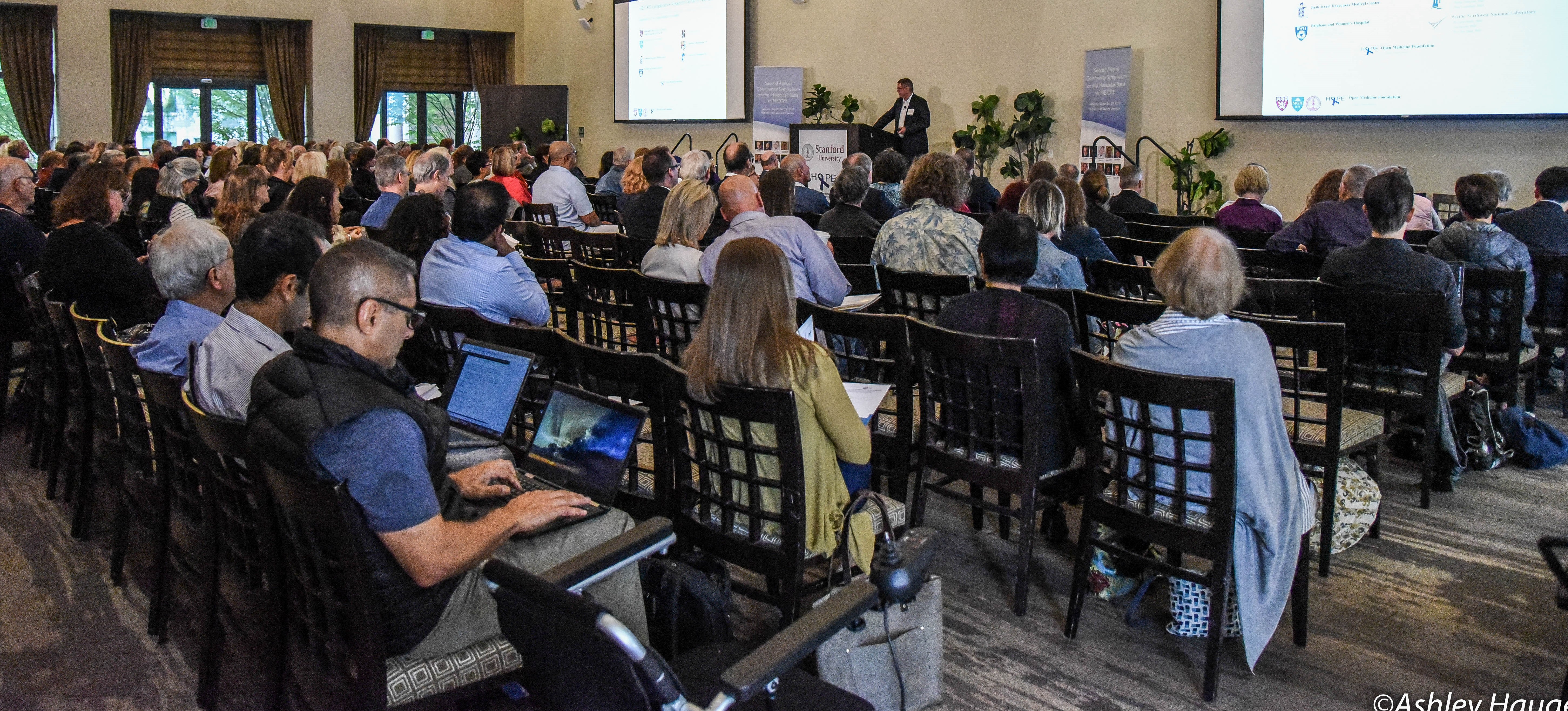By Christopher Armstrong, PhD
During the last week of September, a 3-day Working Group Meeting on the Molecular Basis of ME / CFS was capped off by a Community Symposium at Stanford University. It was the second annual meeting of its kind built upon the success of the year before with the working group meeting stretching out an extra day beyond its predecessor. The quantity of contributing researchers was impressive, but the quality of the research was particularly inspiring.
The message of the year before was about trying to accumulate as much information as possible, to gather the puzzle pieces. This year the puzzle pieces have begun to be resolved with the next challenge to determine how they fit together.
The Community symposium began with a welcome from Linda Tannenbaum, OMF Founder and CEO/President, greetings from Janet Dafoe, patient liaison, and opening remarks by Ron Davis, symposium chair.

The talks began with Dr. Raeka Aiyar, the Symposium moderator, who now works for the New York Stem Cell Foundation (NYSCF). Stem cell applications for research is an area that Dr. Aiyar believes has the potential for helping understand ME / CFS and to find treatments.
 Dr. Oystein Fluge gave the Keynote Address. Unable to provide specific details about the recent Rituximab trial, Dr. Fluge went on to elaborate on previous studies of metabolism on ME / CFS patients and other prospective clinical trials that are underway. Their lab is uniquely set up to allow interaction between clinical trials and observational research with both areas concurrently informing the other.
Dr. Oystein Fluge gave the Keynote Address. Unable to provide specific details about the recent Rituximab trial, Dr. Fluge went on to elaborate on previous studies of metabolism on ME / CFS patients and other prospective clinical trials that are underway. Their lab is uniquely set up to allow interaction between clinical trials and observational research with both areas concurrently informing the other.
The current clinical trial Dr. Fluge is working on is CycloMe, an open-label phase 2 trial looking at the effect of cyclophosphamide on ME / CFS patients. “The results are interesting!” However, more details are not able to be shared until publication.
The central point of their metabolism studies is that it is consistent with several other publications from other researchers. The additional information they provide is an inhibited pyruvate dehydrogenase complex (PDH), an enzyme that enables the entry of sugar breakdown products to enter the mitochondria (the powerhouse of the cell). Interestingly, this enzyme is a central energy metabolism control point that can determine if sugar is largely used for energy production or if amino acids and fatty acids are being utilised instead. The latter seems to be the consensus findings across research groups.
 Dr. Wenzhong Xiao unloads a wealth of findings from the Severely Ill Patient Study (SIPS) he heads up at Stanford. Sleep monitoring determined several alterations compared to healthy controls, while morning cortisol levels were also attenuated. Together this indicates a significant impact to the sleep/wake cycle of people with ME / CFS. Viral pathogens have long been tied to ME / CFS with no consistent findings. Dr. Xiao described an extensive virus search that found no significant difference in viral pathogens between patients and controls. The study of the microbiome revealed variations in the bacteria of the gut, and interestingly, a neuroprotective metabolite (3-Indolepropionate) produced by gut bacteria appears to be significantly reduced in ME / CFS patients.
Dr. Wenzhong Xiao unloads a wealth of findings from the Severely Ill Patient Study (SIPS) he heads up at Stanford. Sleep monitoring determined several alterations compared to healthy controls, while morning cortisol levels were also attenuated. Together this indicates a significant impact to the sleep/wake cycle of people with ME / CFS. Viral pathogens have long been tied to ME / CFS with no consistent findings. Dr. Xiao described an extensive virus search that found no significant difference in viral pathogens between patients and controls. The study of the microbiome revealed variations in the bacteria of the gut, and interestingly, a neuroprotective metabolite (3-Indolepropionate) produced by gut bacteria appears to be significantly reduced in ME / CFS patients.
Dr. Xiao caps off his findings by displaying an integrative web of all associated data points from the SIPS study connected to the central diagnosis of ME / CFS. The hope is to add the data from other studies to discover if the connected associations continue to hold.
 Next up is Dr. Jonas Bergquist discussing his new study looking at peptides and protein markers in the cerebrospinal fluid (CSF) from ME / CFS patients, Multiple Sclerosis (MS) patients and healthy controls. He reveals preliminary data from the study that show elevations of protein markers indicative of neuroinflammation, cell damage and repair in ME / CFS, and significant differences are observed between MS and ME / CFS patients.
Next up is Dr. Jonas Bergquist discussing his new study looking at peptides and protein markers in the cerebrospinal fluid (CSF) from ME / CFS patients, Multiple Sclerosis (MS) patients and healthy controls. He reveals preliminary data from the study that show elevations of protein markers indicative of neuroinflammation, cell damage and repair in ME / CFS, and significant differences are observed between MS and ME / CFS patients.
Secondly, Dr. Berquist screens for steroid levels and has found a decrease of pregnenolone with non-significant downregulation of most other steroids. Pregnenolone is a neurosteroid produced in the mitochondria.
Thirdly, Adrenergic and Muscarinic receptor autoantibodies were significantly elevated in plasma from ME / CFS, and this has now been observed in two separate studies. Importantly, no such autoantibody changes were found in the CSF.
 Dr. Alain Moreau is looking into the role of circulating microRNA in ME / CFS. MicroRNA are small molecules that circulate throughout the body and can regulate the production of proteins and enzymes from genes. He hypothesizes that “ME / CFS is caused by a disturbance in the expression of microRNAs, which modulate immune functions, energy metabolism and physiological stress response”. Dr. Moreau uses a massager arm cuff to stimulate a reaction in ME / CFS patients, a simile to post-exertional malaise. He measures the microRNA before and after this stimulation and measures the alteration that occurs in ME / CFS as compared to controls. Significant variations occur between ME / CFS and controls. Furthermore, the data is able to be split into 4 subtypes based on the microRNA, which relates to variations in symptom expression.
Dr. Alain Moreau is looking into the role of circulating microRNA in ME / CFS. MicroRNA are small molecules that circulate throughout the body and can regulate the production of proteins and enzymes from genes. He hypothesizes that “ME / CFS is caused by a disturbance in the expression of microRNAs, which modulate immune functions, energy metabolism and physiological stress response”. Dr. Moreau uses a massager arm cuff to stimulate a reaction in ME / CFS patients, a simile to post-exertional malaise. He measures the microRNA before and after this stimulation and measures the alteration that occurs in ME / CFS as compared to controls. Significant variations occur between ME / CFS and controls. Furthermore, the data is able to be split into 4 subtypes based on the microRNA, which relates to variations in symptom expression.
 Dr. Maureen Hanson follows in a similar vein to Dr. Moreau by looking at studying ME / CFS patients before and after an exercise challenge to compare the dynamic response of ME / CFS patients as compared to healthy controls. This study will focus on metabolite, gene expression and cytokines. Similarly, a second study looking at ME / CFS patients on Ampligen will look at symptom changes over time in conjunction with changes in metabolites, gene expression and cytokines.
Dr. Maureen Hanson follows in a similar vein to Dr. Moreau by looking at studying ME / CFS patients before and after an exercise challenge to compare the dynamic response of ME / CFS patients as compared to healthy controls. This study will focus on metabolite, gene expression and cytokines. Similarly, a second study looking at ME / CFS patients on Ampligen will look at symptom changes over time in conjunction with changes in metabolites, gene expression and cytokines.
Dr. Hanson also reports on a new metabolomics study looking at ME / CFS compared to controls. The findings align nicely with previous studies, and upon analyzing data across other studies in the field, there were no separate sub-groups identifiable based on the metabolites.
 Dr. Ron Tompkins begins by talking about the initiation of the ME / CFS Collaborative Research Center at Harvard (which Dr. Davis affectionately calls the “Stanford of the East”). Dr. Tompkins professes his embarrassment as a Doctor by the way his community generally responds to a disease they don’t understand. Dr. Tompkins has spent a lot of time researching the impact of significant trauma on the body that was significant enough to kill you (a 20% mortality rate). Through these studies he has a strong working knowledge on the interplay of inflammation, immunity and metabolism.
Dr. Ron Tompkins begins by talking about the initiation of the ME / CFS Collaborative Research Center at Harvard (which Dr. Davis affectionately calls the “Stanford of the East”). Dr. Tompkins professes his embarrassment as a Doctor by the way his community generally responds to a disease they don’t understand. Dr. Tompkins has spent a lot of time researching the impact of significant trauma on the body that was significant enough to kill you (a 20% mortality rate). Through these studies he has a strong working knowledge on the interplay of inflammation, immunity and metabolism.
The initial research they aim to begin is a thorough understanding of muscle recovery with a multi-omic exploration of muscle biopsies from ME / CFS patients, the first study of its kind. They also wish to begin functional neuroimaging studies. The focus seems to be on understanding the differences in tissues of the body as distinct from blood plasma and immune cells.
With enhanced funding, the Research Center at Harvard would be ideal for a setup of clinical trials to fast-track promising and potential treatments for ME / CFS.
 Michael Sikora is a graduate student under Lars Steinmetz, professor of genetics and member of the Stanford Genome Technology Center who are collaborating with Mark Davis. He has been working to establish the role of T cells and the immune system in ME / CFS. They have found the significant increase in T cells in ME / CFS patient compared to controls indicating an activated immune response. Furthermore, the T cell expansion signature appears distinct in ME / CFS from other diseases like Multiple Sclerosis and Lyme disease where immune activation is also present. Currently, they are focusing on the cause for the immune activation, whether it’s in response to an infection or in response to self (autoimmunity).
Michael Sikora is a graduate student under Lars Steinmetz, professor of genetics and member of the Stanford Genome Technology Center who are collaborating with Mark Davis. He has been working to establish the role of T cells and the immune system in ME / CFS. They have found the significant increase in T cells in ME / CFS patient compared to controls indicating an activated immune response. Furthermore, the T cell expansion signature appears distinct in ME / CFS from other diseases like Multiple Sclerosis and Lyme disease where immune activation is also present. Currently, they are focusing on the cause for the immune activation, whether it’s in response to an infection or in response to self (autoimmunity).
 Dr. Jarred Younger discusses his recent research on neuroinflammation. Using a similar technique to an MRI, Dr. Younger can evaluate the levels of metabolites in sections of the brain. Lactate is a metabolite found as the product of sugar breakdown for energy production (known as the process of glycolysis). Lactate was found to be elevated in areas of the brain that are responsible for the sickness response. “This is exactly what would happen if ME / CFS was a neuroinflammatory disorder”, Dr. Younger explained. The method used also enables the prediction of temperature in the brain, and temperature increase is apparent in the brain of ME / CFS patients.
Dr. Jarred Younger discusses his recent research on neuroinflammation. Using a similar technique to an MRI, Dr. Younger can evaluate the levels of metabolites in sections of the brain. Lactate is a metabolite found as the product of sugar breakdown for energy production (known as the process of glycolysis). Lactate was found to be elevated in areas of the brain that are responsible for the sickness response. “This is exactly what would happen if ME / CFS was a neuroinflammatory disorder”, Dr. Younger explained. The method used also enables the prediction of temperature in the brain, and temperature increase is apparent in the brain of ME / CFS patients.
The same regions of the brain in which Dr. Younger had found elevations in lactate and temperature indicative of neuroinflammation were also previously observed to have activated microglia, which are consistent with neuroinflammation.
 Dr. Ron Davis discusses the search for biomarkers with a particular focus on three new technologies being developed to find differences between ME / CFS and healthy controls. First, he reintroduces the impedance test as a marker for ME / CFS. The addition of salt to ME / CFS and control plasma was enough to produce a significant alteration in the ME / CFS impedance signal as opposed to the control signal. Second, new technology produced in conjunction with San Jose State University looks to assess red blood cell deformability in ME / CFS patients by evaluating the speed of transit through a tiny capillary. They have found that ME / CFS cells are significantly less deformable than healthy cells. Finally, magnetic levitation of cells shows that ME / CFS white blood cells are lighter than those of healthy controls. All these instruments effectively separate ME / CFS and control plasma, red blood cells or white cells, and each is fabricated for a very low cost. It’s possible to create a device that combines these methods of detection to enhance specificity. All these instruments in conjunction with metabolite tests from Dr. Robert Naviaux and Dr. Robert Phair will be compared in a “bake-off” to determine the most effective diagnostic for ME / CFS. The key for a successful diagnostic is that it accurately identifies illness (low false positives and false negatives, is easy to produce and simple enough to perform that it may be usable anywhere.
Dr. Ron Davis discusses the search for biomarkers with a particular focus on three new technologies being developed to find differences between ME / CFS and healthy controls. First, he reintroduces the impedance test as a marker for ME / CFS. The addition of salt to ME / CFS and control plasma was enough to produce a significant alteration in the ME / CFS impedance signal as opposed to the control signal. Second, new technology produced in conjunction with San Jose State University looks to assess red blood cell deformability in ME / CFS patients by evaluating the speed of transit through a tiny capillary. They have found that ME / CFS cells are significantly less deformable than healthy cells. Finally, magnetic levitation of cells shows that ME / CFS white blood cells are lighter than those of healthy controls. All these instruments effectively separate ME / CFS and control plasma, red blood cells or white cells, and each is fabricated for a very low cost. It’s possible to create a device that combines these methods of detection to enhance specificity. All these instruments in conjunction with metabolite tests from Dr. Robert Naviaux and Dr. Robert Phair will be compared in a “bake-off” to determine the most effective diagnostic for ME / CFS. The key for a successful diagnostic is that it accurately identifies illness (low false positives and false negatives, is easy to produce and simple enough to perform that it may be usable anywhere.
 Dr. Robert Phair is now known as the “metabolic trap guy”. He comes from a background of engineering and physiology and hopes to apply systems engineering to human physiology. His focus is on modeling of complex metabolic systems, with a corrent focus on substrate inhibiting enzymes.
Dr. Robert Phair is now known as the “metabolic trap guy”. He comes from a background of engineering and physiology and hopes to apply systems engineering to human physiology. His focus is on modeling of complex metabolic systems, with a corrent focus on substrate inhibiting enzymes.
He emphasizes that the outbreaks of ME / CFS were a particularly important clue to him that suggested that any genetic component related to the illness would likely be common.
He discusses non-linear system theory as important for biology but especially important in explaining some of the confounding elements of ME / CFS. His hypothesis began with identifying areas of metabolism that could form bi-stability, two steady states that can be entered into that are functionally distinct from each other, one healthy and one unhealthy.
First he found mutations in a gene called IDO2. IDO2 is an enzyme that converts tryptophan (an essential amino acid) to kynurinine. Tryptophan is also processed to seratonin. IDO2 is one of two enzymes that process tryptophan, the other being IDO1. These two enzymes seem to do identical things, but it’s actually more complicated. At lower levels of tryptophan, IDO1 converts tryptophan to kynurenine, but IDO2 is inactive. But IDO1 is a substrate-inhibited enzyme whereby too much tryptophan in a cell stops its function, causing tryptophan to no longer be processed and build up its levels in the cell. At these high levels of tryptophan, IDO2 takes over the processing of tryptophan. However, all the ME / CFS patients in the SIPS cohort had mutations in IDO2 making it non-functional. Without IDO2 there is essentially a block created that stops tryptophan converting to kynurenine and could force it through to serotonin.
Flux experiments were initiated to measure the levels of tryptophan and kynurenine in ME / CFS white blood cells; these showed that tryptophan is higher and kynurenine is lower than in healthy controls, consistent with the existence of a metabolic trap in the patients tested. These experiments have only been conducted on 6 ME / CFS patients and 6 healthy controls so far, and more patients will be tested as fast as possible.
Dr. Ron Davis closes the symposium by explaining the importance of Dr. Phair’s findings but also warns about cherry-picking of data to support a hypothesis. Good science is accomplished by forming a testable hypothesis that makes specific predictions and doing experiments to see if those predictions obtain. This work is still at the beginning and will require much more exploration to determine whether it is definitive of ME / CFS. Dr. Davis also emphasizes the need for funding at the present time. To any big donors out there, he urged, “This is the time to donate, as we may be on the precipice of a crucial finding for the illness.” Dr. Davis then explained how fundamental these pathways are to the control of a person’s biochemistry, and that It’s exceptionally dangerous to begin experimenting on one’s self without more information. Self-experimentation could have dire consequences. Dr. Davis implores the patients to be patient.
In summary, Dr. Davis states: “A lot of progress has been made in the last year. There is a lot more data and it is now generating testable hypotheses. More exciting collaborations are being established. Excellent new people are entering the field. The future is looking even more hopeful. Our partnership with OMF has been instrumental for this progress and for the support of this symposium. We are now on the brink of even more exciting progress, but as always, funding is the rate-limiting step. Now is a crucial time to donate to accelerate the breakthroughs.”



